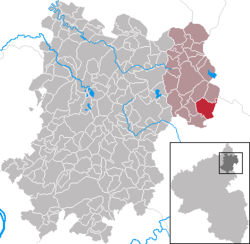파보니스 에타
Eta Pavonis| 관측 데이터 에폭 J2000 이쿼녹스 J2000 | |
|---|---|
| 별자리 | 파보 |
| 우측 상승 | 17h 45m 43.98605s[1] |
| 탈위임 | −64° 43′ 25.9394″[1] |
| 겉보기 크기 (V) | 3.61[2] |
| 특성. | |
| 스펙트럼형 | K2II[3] |
| U-B색지수 | +1.17[4] |
| B-V색지수 | +1.19[4] |
| 아스트로메트리 | |
| 방사 속도 (Rv) | -7.60km[5]/s |
| 고유 운동 (μ) | RA: −11.96[1]mas/yr Dec.: −56.57[1]mas/yr |
| 시차 (π) | 9.26 ± 0.18[1] mas |
| 거리 | 352 ± 7 리 (102 ± 2 pc) |
| 절대치수 (MV) | −1.56[2] |
| 세부 사항 | |
| 미사 | 3.98[6] M☉ |
| 반지름 | 33.49+8.17 −4.57[7] R☉ |
| 루미도 | 469±20[7] L☉ |
| 표면 중력 (log g) | 1.97[8] cgs |
| 온도 | 4,642+354 −480[7] K |
| 금속성 [Fe/H] | +0.15[8] 덱스 |
| 회전 속도 (v sin i) | < 1.5km[9]/s |
| 기타 지정 | |
| 데이터베이스 참조 | |
| 심바드 | 자료 |
에타 파보니스(Eta Pavonis)는 on 파보니스(Pavonis)에서 라틴화된 이름으로, 파보 남쪽 별자리에 있는 단일[11] 별이며, 아라 옆에 있는 서쪽 별자리 경계 근처에 위치한다. 주황색 빛깔을 띠며 육안으로 볼 수 있으며, 외관상 시각적 크기는 3.61이다.[2] 시차를 기준으로 이 물체는 태양으로부터 약 350광년(108pc) 거리에 위치한다.[1] 절대폭은 -1.56이며,[2] 방사상 속도 -7.6 km/s로 더 가까이 표류하고 있다.[5]
이것은 별 분류 K2를 가진 진화된 밝은 거대한 별이다.II,[3] 거인과 초거성의 분류 사이에. 중심부의 수소 공급이 소진되면서 태양의 33.5배 반경까지 확대됐다.[7] 이 별은 4,642K의 유효 온도에서 확대된 광구에서 태양의 469배[7] 밝기를 발산하고 있다.[7]
참조
- ^ a b c d e f Van Leeuwen, F. (2007). "Validation of the new Hipparcos reduction". Astronomy and Astrophysics. 474 (2): 653–664. arXiv:0708.1752. Bibcode:2007A&A...474..653V. doi:10.1051/0004-6361:20078357. S2CID 18759600. Vizier 카탈로그 항목
- ^ a b c d Anderson, E.; Francis, Ch. (2012). "XHIP: An extended hipparcos compilation". Astronomy Letters. 38 (5): 331. arXiv:1108.4971. Bibcode:2012AstL...38..331A. doi:10.1134/S1063773712050015. S2CID 119257644. Vizier 카탈로그 항목
- ^ a b Houk, N.; Cowley, A. P. (1975). University of Michigan Catalogue of two-dimensional spectral types for the HD stars. Vol. 1. Department of Astronomy, University of Michigan. pp. 19 + 452. Bibcode:1975mcts.book.....H.
- ^ a b Mallama, A. (2014). "Sloan Magnitudes for the Brightest Stars". The Journal of the American Association of Variable Star Observers. 42 (2): 443. Bibcode:2014JAVSO..42..443M.Vizier 카탈로그 항목
- ^ a b Gontcharov, G. A. (2006). "Pulkovo Compilation of Radial Velocities for 35 495 Hipparcos stars in a common system". Astronomy Letters. 32 (11): 759–771. arXiv:1606.08053. Bibcode:2006AstL...32..759G. doi:10.1134/S1063773706110065. S2CID 119231169.
- ^ Charbonnel, C.; Lagarde, N.; Jasniewicz, G.; North, P. L.; Shetrone, M.; Krugler Hollek, J.; Smith, V. V.; Smiljanic, R.; Palacios, A.; Ottoni, G. (2020). "Lithium in red giant stars: Constraining non-standard mixing with large surveys in the Gaia era". Astronomy and Astrophysics. 633: A34. arXiv:1910.12732. Bibcode:2020A&A...633A..34C. doi:10.1051/0004-6361/201936360. S2CID 204907220.
- ^ a b c d e f Brown, A. G. A.; et al. (Gaia collaboration) (August 2018). "Gaia Data Release 2: Summary of the contents and survey properties". Astronomy & Astrophysics. 616. A1. arXiv:1804.09365. Bibcode:2018A&A...616A...1G. doi:10.1051/0004-6361/201833051. 이 소스에 대한 가이아 DR2 기록 VizieR.
- ^ a b Luck, R. Earle (2014). "Parameters and Abundances in Luminous Stars". The Astronomical Journal. 147 (6): 137. Bibcode:2014AJ....147..137L. doi:10.1088/0004-6256/147/6/137.
- ^ De Medeiros, J. R.; Alves, S.; Udry, S.; Andersen, J.; Nordström, B.; Mayor, M. (2014). "A catalog of rotational and radial velocities for evolved stars". Astronomy & Astrophysics. 561: A126. arXiv:1312.3474. Bibcode:2014A&A...561A.126D. doi:10.1051/0004-6361/201220762. S2CID 54046583. Vizier 카탈로그 항목
- ^ "eta Pav". SIMBAD. Centre de données astronomiques de Strasbourg. Retrieved 2020-05-20.
- ^ Eggleton, P.P.; Tokovinin, A.A. (September 2008). "A catalogue of multiplicity among bright stellar systems". Monthly Notices of the Royal Astronomical Society. 389 (2): 869–879. arXiv:0806.2878. Bibcode:2008MNRAS.389..869E. doi:10.1111/j.1365-2966.2008.13596.x. S2CID 14878976.



